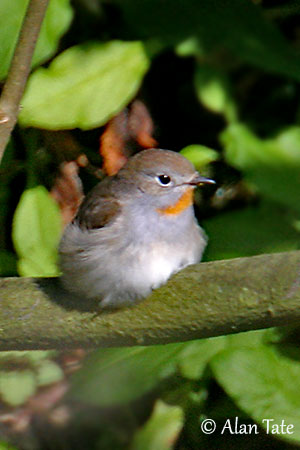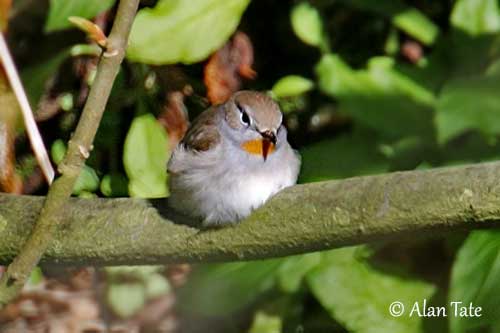
Fr: Gobemouche de la taïga
Ang: Taiga Flycatcher
All: Taigazwergschnäpper
Esp: Papamoscas de la taiga
Ita: Pigliamosche della taiga
Nd: Taigavliegenvanger
Sd: tajgaflugsnappare
Photographers:
Didier Buysse
Vision d’Oiseaux
William Price
PBase-tereksandpiper & Flickr William Price
Alan & Ann Tate
AA Bird Photography
Ingo Waschkies
Bird Photography
Text by Nicole Bouglouan
Sources:
HANDBOOK OF THE BIRDS OF THE WORLD Vol 11 by Josep del Hoyo, Andrew Elliott and David Christie - Lynx Edicions - ISBN: 849655306X
A Field Guide to the Birds of South-East Asia by Craig Robson. New Holland Publishers. ISBN: 9781780090498
Sibirds.ru – Siberian Birdwatching Community
Wikipedia, the free encyclopaedia
Taiga Flycatcher
Ficedula albicilla
Passeriformes Order – Muscicapidae Family
INTRODUCTION:
The Taiga Flycatcher was formerly a subspecies of the Red-breasted Flycatcher, but it is now a full species. It was first described in 1811 by Peter Simon Pallas, a Prussian zoologist and botanist who worked in Russia.
The Taiga Flycatcher breeds in N Eurasia, from E Russia to Siberia and Mongolia. It migrates southwards to spend the winter in S and SE Asia. It is a rare vagrant to W Europe.
It frequents open woodlands, forest edges, secondary growths, parks and gardens. It feeds primarily on insects and various invertebrates, arthropods, earthworms and snails.
This species is monogamous. The female builds a cup-shaped nest in a hole in tree or wall, some metres above the ground. It is solitary nester.
The Taiga Flycatcher is described as widespread and common in the winter range, and the population is stable. The species is not globally threatened.

DESCRIPTION OF THE BIRD:
Biometrics:
Length: 11-13 cm
Wingspan: 20 cm
Weight: 14 g
The Taiga Flycatcher is slightly larger than the Red-breasted Flycatcher.
In breeding plumage, the male has brown to greyish-brown head and upperparts, but the uppertail-coverts are darker, almost blackish. The tail is blackish with white at base of outer rectrices.
The underparts are white with peach tinge. Chin and throat are rufous-orange, broadly bordered with grey.
On the brown head, lores, malar area and ear-coverts are grey.
The pointed bill is blackish with yellowish tinge and it is variably dark towards the tip. The eyes are brown, surrounded by white, feathered eyering, usually more conspicuous below the eye. Legs and feet are dark brown to blackish.
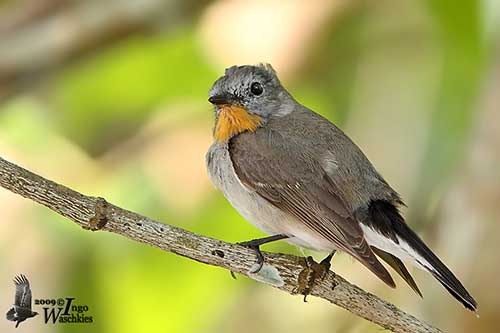
In non-breeding plumage, the male has reduced rufous-orange patch. On the underparts, flanks are more buffish.
The female resembles male but she lacks the red throat which is mostly white. The underparts are greyish-buff.
The first winter resembles female, but greater coverts and tertials have buffish tips.
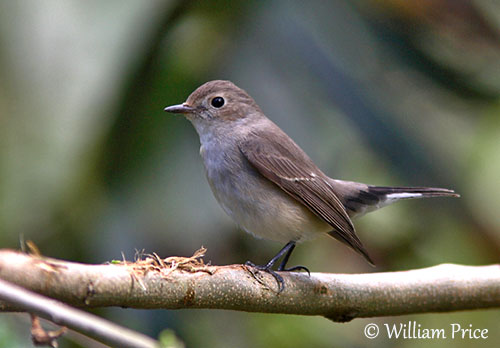
RANGE:
The Taiga Flycatcher breeds from E European Russia, E to Siberia (to Kamchatka), and S to extreme NE Kazakhstan, N Mongolia and Amurland.
It winters from S Nepal E to N India, Bangladesh, SE Asia and SE China. The species is a rare vagrant to W Europe.
HABITAT:
The Taiga Flycatcher frequents deciduous and mixed forests in mountains, favouring those with dense undergrowth and tall trees. It prefers open woodlands with clearings and areas near water.
On migration, it is found in bush thickets, man-made forests and groves.
During winter, it occurs in forests, woodlands, plantations, parks and gardens, up to 2,000 metres of elevation.
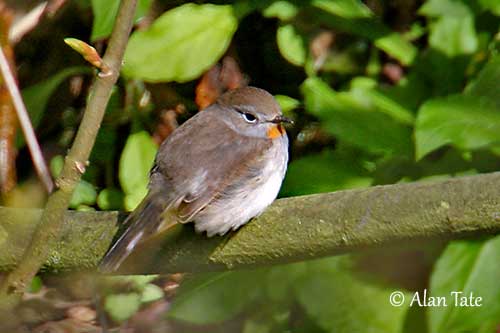
CALLS AND SONGS: SOUNDS BY XENO-CANTO
The Taiga Flycatcher utters a soft rattling “trrr” and less frequently, some dry, clicking “tek” notes, and also a harsh “zree” or “zee-it”.
The song is a fast sequence of rhythmic notes, first sharp and high-pitched, and then ending clear and descending “zri zri zri chee chee dee-cha dee-cha dee-cha chu chu chu tu tu tu tu too taa”.
BEHAVIOUR IN THE WILD:
The Taiga Flycatcher feeds primarily on insects such as coleopterans and spiders. Arthropods including Odonata, Plecoptera, Orthoptera and Dermaptera to Hemiptera, adults and larvae of Lepidoptera and Diptera species are also part of the diet, with opiliones, woodlice, earthworms and snails.
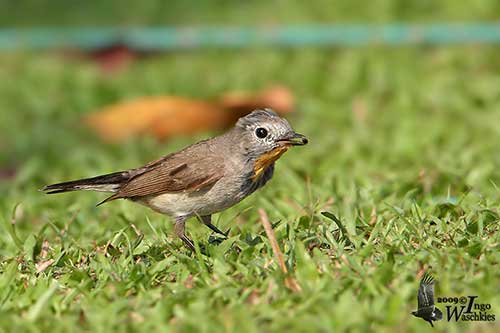
It usually forages alone, from middle level to the ground, by hopping and creeping among the vegetation, and sometimes hovering. It catches flying insects by short sallies with rapid wingbeats, but it also forages on the ground.
Like numerous Muscicapidae, it often flicks both wings and tail.
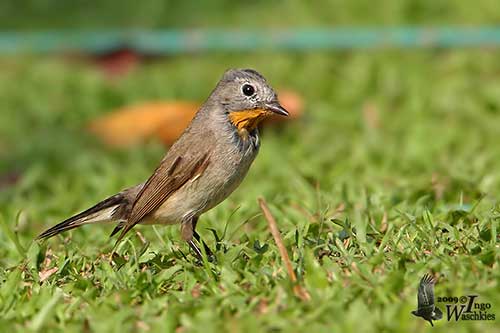
The Taiga Flycatcher is monogamous and nests in isolated pairs. The cup-shaped nest is built by the female some metres above the ground, in hole in tree or wall, but it also accepts nest-boxes.
The courtship displays are poorly known, but this behaviour often involves courtship feeding by male to female, and the male may also feed her at nest.
We can also suggest that the bright-coloured throat patch is displayed and enhanced by adapted postures.
The Taiga Flycatcher is migratory. They leave the breeding grounds from August to late October, passing through E China between mid-September and late October.
The return migration starts in April/May, with passage through N China and Mongolia continuing until early June.
Vagrants are recorded as far West as Britain.
The flight is direct and fluttering with shallow wingbeats.
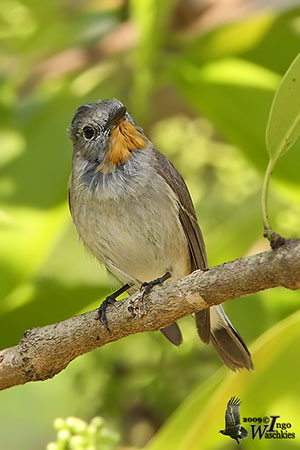
REPRODUCTION OF THIS SPECIES:
The breeding season takes place from mid-June to August. This species is solitary nester and produces a single brood per season.
The nest of the Taiga Flycatcher is built by the female, a cup-shaped structure made of moss, grass stalks, leaves and root fibres. The cup is lined with hair. Lichen or moss is sometimes woven into the outer wall of the nest. It is built 4 metres or more above the ground, and can be placed in hole in tree or wall, but also on a branch close to the trunk. This species may also use nest-boxes if available, and abandoned nest by woodpeckers and other species.
The female lays 5-6 eggs and incubates alone during 12-15 days. She may be fed by the male during this period. The female broods the chicks, but both parents feed them. The young fledge 11-15 days after hatching, but they still depend on adults for some days.
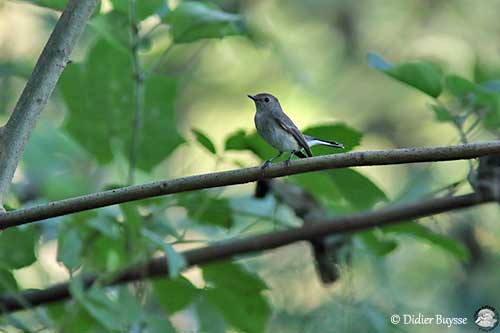
PROTECTION / THREATS / STATUS:
The Taiga Flycatcher has large range in which it is described as widespread and common, especially in the non-breeding range in India and Pakistan. It is irregular to rare in the other parts of the range.
The size of the population is unknown, but it is suspected to be stable and the species is not globally threatened.
The Taiga Flycatcher is currently evaluated as Least Concern.
